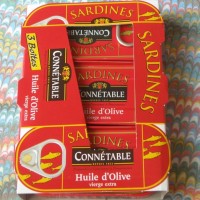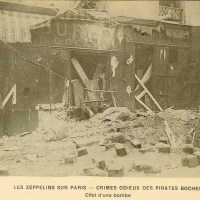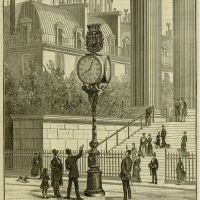We do not, as a rule, take early-morning walks in Paris. If we do not have a morning appointment, we tend to dawdle over breakfast, reading and chatting and enjoying the view from the windows. Quick showers are not an option: the apartment has a deep bathtub that is an invitation to more reading, or to daydreaming. By the time we are on our way, we are ready for mid-morning coffee or even lunch.
So I do not remember what it was about that June morning that got us out the door at 6:30 a.m. It was not an invitingly sunny day; it had rained overnight and the sky was still grey. We took an umbrella. But something drew us outdoors, where the stallholders were setting up the market on the boulevard.
We passed a snail, heading towards the lettuce stall, clearly hoping for a dropped leaf.
He was quite safe; the boulevard was deserted.
We turned down the rue de la Santé, past the high prison walls on one side and the lower walls of the Lycée Notre Dame de France on the other, with its empêche-pipi in a corner.
A worker for the sanitation department waved at us from his green truck as we walked under the elevated Metro line on the boulevard Saint-Jacques.
From there, we wandered down the rue Ferrus, curious about the archway visible at its far end. As we got nearer it resolved itself into the blue gate of the Centre Hospitalier Sainte-Anne, with a pigeon surveying the scene from the knob on top.
As we stood peering through the gate, the man in the guardhouse invited us to come in and look around.
The interior boulevard drew us into a miniature town.
There were streets and sidewalks and walls and streetlights. I took a photo of one of the lights and only later, as I re-examined the photo, noticed the plaque about the huge German bomb – “obus” – that had fallen here near the end of the First World War.
There were parks and gardens on every side, many with statues.
A war memorial indicated that this was, in fact, a psychiatric hospital.
Eventually we found a plaque that answered some of our questions. In the 15th century, the site had housed a sanitarium for people with contagious diseases, which was given the name of Sainte-Anne in 1650 in honour of its patron Anne of Austria (mother of Louis XIV). It included a farm where the patients could work as they regained their health.
In the 1860s, on the orders of Napoleon III, this hospital-farm was transformed into a psychiatric institution for the treatment of and research into mental illness. Napoleon III asked Baron Georges-Eugène Haussmann to make it happen, and Haussmann delegated the task to an architect called Charles-Auguste Questel. Another historic panel showed the buildings in his original plan, many of which are still standing.
A motto from Questel was included on the descriptive plaque:
« Il faut penser sans cesse à l’harmonie générale, les détails viendront toujours. »
“One must think continuously of the general harmony, the details will always come.”
The principle seems to have worked well here. A “general harmony” was evident in the arrangement of larger buildings, smaller pavilions, colonnades, paths, gardens, and wooded areas (we later found a website from which we learned that there are more than 1,000 trees on this 14-hectare site).
Granted, it was so early in the day that there was nobody about, but we were struck by the sense of peace and calm as we explored.
Eventually we returned to the front gate and turned left into the rue Cabanis, where we passed an unusual installation: three glass-fronted panels containing wooden boards on which words in distinctive capital letters had been carved. An explanatory panel provided a transcription. Another identified them as the “Plancher de Jeannot.”
They are floorboards, taken from a house in the Béarn region near the Pyrenees, carved by a young man who had returned traumatized from fighting the war in Algeria in 1959 to find that his violent and abusive father had committed suicide. When his mother died in 1971, he withdrew from the world and carved a message into the floor of his room, beginning with the words:
LA RELIGION A INVENTE DES MACHINES A COMMANDER LE CERVEAU DES GENS ET BETES…
“Religion invented machines to control the mind of people and animals…”
He died not long after completing his message, in 1972, aged 33. Two decades later, his sad testimonial was found and conserved by the purchaser of the farm – a retired psychiatric doctor. The boards have been exhibited in museums as examples of “art brut” (outsider or naïve art) – which seems disrespectful to the sufferings of this young man, who was not trying to create art, but to put into words what he saw as the source of his suffering. The boards finally found a home near the Sainte-Anne Hospital, where passersby may draw their own conclusions about what they mean and how they should be considered.
Our final discovery came as we made our way home along the Avenue René Coty. Another hospital, in a beautiful 18th-century building – the Hôpital Rochefoucauld. It was originally intended for aged and ill members of the military and clergy. It is now a geriatric and palliative care hospital.
In stark contrast with the serene white buildings is a small, ugly, much-graffitied hut on the lawn.
What on earth? we wondered. On Google Maps, this blot on the landscape is identified as “Regard XXV de l’aqueduc Medicis.” Wikipedia helpfully provides the alternative name of “Regard de Saux.” All this takes a bit of translation.
In fact, it is a very old and elaborate cover for a shaft allowing maintenance staff access to an underground watermain (what used to be called a “manhole”). “Regard” probably meant it allowed people to go down and take a look. There were 27 of these Regards along the route of the Medici aqueduct from Rungis, which is south of Paris, into the city. The aqueduct dates from 1623 and is still in service, an admirable example of long-lasting municipal infrastructure. The last of the “regards” is a fairly large building beside the Observatoire.
We were home by 8:30 a.m. Our walk through the 14th arrondissement had evoked its history as an area beyond the old city walls filled with convents and monasteries, with their gardens and orchards and tree-lined walkways. A few convents remain, glimpsed through archways or beyond high walls. The many hospitals in this district are their legacy, for hospitality and caring for the sick was once the work of religious establishments.
Two vast convent gardens survive – one behind the Monastère de la Visitation, visible from the rue Boissonade, another behind the Maison Santé des Soeurs Augustines, part of which is just visible from the very end of the Square de Port Royal. We have walked all around the blocks in which these gardens form the centre, hoping for a better view, but have always been disappointed. Perhaps we need to get up earlier in the morning…
Text and photographs by Philippa Campsie; photograph of the Plancher de Jeannot from Google Street View.
We wish all our readers a very happy New Year in 2020.





































Thanks and Happy Holly-Daze to you. Cheers, Barney
Le Plancher de Jeannot reads as a very sad story. His floor writings have been classified as “art brut”, a subject that interests me and I thank you for bringing them to my attention. Now I must find an English translation of Ingrid Thobois’ book because my french comprehension is still very basic. Early search, I think not.
When we are at home on the Oregon Coast, we dawdle, like you, and rarely make an appearance anywhere before 9:00 although I am up by 6:00. But when we travel, especially in Europe, we treasure those dawn-is-breaking walks, while cities and towns come alive. I never tire of Venice at dawn or Rome before the traffic intensifies. We’ve done our share of Paris walks after we’ve tumbled out of bed and before breakfast as well. It’s delightful to find a little neighborhood place with fresh croissant and a steaming coffee. Thanks for kindling fond memories!
On our next visit, we shall try to get out the door a bit earlier. There is so much to see (from snails to croissants) for the early birds.
Thank you for sharing your thoughtful and rewarding randonée. While I’m grieving Nôtre Dame and the general state of the world at present, it’s so reassuring to be reminded that people have been through a great deal for quite some time now, and have also been trying to make things better!
What a charming walk!
Dear Philippa, Thanks for the great ballad. Two anecdotes came to mind when I was reading it. Regarding the writing on wooden planks, you should read the fascinating tale of Joachim Martin: he wrote his life’s and his village’s story on the back of the wooden planks he was using to reconstruct the floor of a castle around 1880s https://fr.wikipedia.org/wiki/Joachim_Martin and https://www.nouvelobs.com/rue89/nos-vies-intimes/20180406.OBS4734/qu-on-le-pende-ce-cochon-le-menuisier-a-tout-deballe-sous-le-plancher-du-chateau.html
Regarding Sainte-Anne, a good friend of mind, handicapped from the middle of the chest down and, therefore, moving around in a wheelchair, used to live close by the psychiatric hospital. Whenever she was taking a taxi back to home, the drivers would usually drop her at the doors of the hospital thinking that, given she was handicapped physically, she was probably a psychiatric patient…
I am struck indeed by the magnificent hospitals and adjacent gardens one can find on the Rive Gauche: Val de Grâce, Pitié, etc., and love to visit them when I have the opportunity.
Again thank you! Bonne Année,
Isabelle.
Thank you, Philippa (if I may be familiar—I feel as though I know you). It is always a pleasure to walk with you and have the advantage of both your observing eye and additional research.
Looking forward to more walks in 2020.
Pingback: Places of healing | Parisian Fields
Pingback: Saving Mary | Parisian Fields